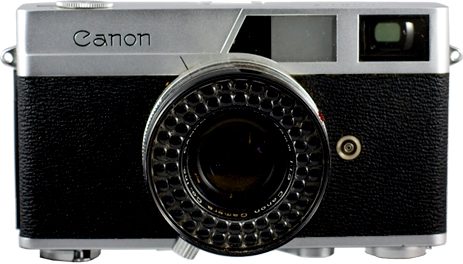
Format: 35mm film
Approx. dates of manufacture: 1960 - 1964
Approx. original price: unknown
Approx. street value: Low
There are a lot of different variations, but the basics are the same. Canon had made high-end 35mm rangefinders for decades, many of them with interchangable lenses. But in 1961 they decided to go down-market with a mid-tier, fixed-lens rangefinder, which they called the Canonet. According to a book, "How Canon Got Its Flash Back," the Canonet was their first mass-produced camera.
That big selenium cell is the obvious way to recognize it. Selenium cells are photovoltaic, which means they generate electricity when light strikes them; so there's a little ammeter inside which measures the current—the more light, the more current and the more the needle deflects. The bubbles on the surface are actually little lenses which restrict the path of the light so that the cell only sees around a 30° angle, similar to what the lens would see. That way the camera meters what it's pointed at.
.jpg) On this camera, the meter is hooked up to the diaphram in the lens to run on "automatic" mode: you choose the shutter speed and the camera picks the appropriate aperture. Nowadays that would be called shutter-priority automation.
On this camera, the meter is hooked up to the diaphram in the lens to run on "automatic" mode: you choose the shutter speed and the camera picks the appropriate aperture. Nowadays that would be called shutter-priority automation.
Another major difference between this camera and its successors is that it has the winder on the bottom housing, not on the top. In the late 50s/early 60s when film advance levers were introduced (as opposed to knobs), sometimes they were on the bottom, sometimes on the back, and only sometimes on top. It wasn't until about the mid-1960s when top-mount levers became the de-facto standard. My Kodak Retina Reflex III has a bottom-mount advance.
If you look at the advertisment (click on it for a larger version), it's fun to see the 1961 version of "full automation." Compare that to Canon's AF35M 20-years later, which has auto-exposure, auto-focus, auto-film advance and auto-film-rewind.
This Canonet was superseded in 1965 by the Canonet QL cameras.
I've got a number of Canonets of various types, but it's only recently that I acquired this selenium-cell version. Unlike almost all of my other Canonets, the shutter on this one works. It's sticky on B and I wouldn't trust the timing on the others, but it does work. The meter, however, appears to be dead.
It's got the ƒ/1.9 lens, which is pretty fast for a rangefinder. ƒ/2.8 and ƒ/3.5 were the typical fare.
What interested me most was how the film-advance lever worked in practice. As I type this, I think I only have one other camera that puts the crank on the bottom (Kodak Retina Reflex III). The Canon's advance lever has a hinge so that the end of it can be folded down in use or folded up against the body for storage. In use, you hold the camera normally. The right hand's index finger sits on the shutter release. The left hand is lower on the body: the middle finger rakes across the bottom of the camera and catches the winder tip, while the index finger pushes a stem that handles the focus. You have to shift one hand or the other to change shutter and aperture rings, but if you have your exposure set, you can quickly knock off a series of shots without having to take your eye away from the viewfinder.
My camera came with the never-ready case. I was surprised to find that it has a slot cut in the bottom so that you can fully access the winder without having to take it out of the case. Nice.
For more information: Canon Camera Museum
Camera manual: Orphan Cameras.com
Modern Photography magazine camera test: May 1961



